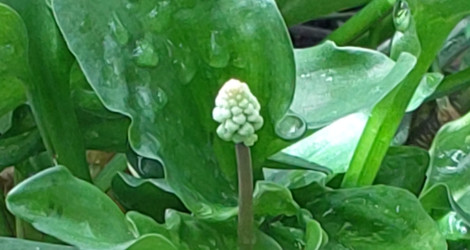Accession Data:
Drimiopsis botryoides Baker
- Common Name: Giant Squill, Measles Leaf
- Family: Asparagaceae Juss.
- Country of Origin: S. Ethiopia to Tanzania

- Habitat: Bushland and woodland on sandy soils; often among rocks
- Description: Herb to 60 cm tall; leaves cordate or lanceolate, spotted or not, to 45x1,5-7,5 cm; inflorescence spicate or racemose; pedicels 0-3 mm long; calyx and corolla of a flower (generally used when the two are similar).">perianth segments white to greenish white, to 6 mm long; outer segments spreading, inner ones connivent and usually wider than the outer; filaments flattened, triangular and united with the perianth segments at their base; capsule subglobose, c. 5 mm Ø. 3
- Culture: Party shade, well drained, moist soil.
- USDA Zone: 10-11
Accession Data:
- Accession # 200100038
- Source: Cheryl Hearty - Vassar College
- Accession Date: 03-30-2001
- Bench: 1107 - AFR:West Bench NC
- Currently: active - healthy
- Qty: 3 confirmed on 07-01-2025
Classification:
- Division: Magnoliophyta
- Class: Liliopsida
- SubClass: monocots
- Order: Asparagales
- SubOrder:
- Family: Asparagaceae
- SubFamily: Scilloideae
- Tribe: Hyacintheae
- SubTribe: Massoniinae
Flowering Data:
This accession has been observed in bloom on:| Year | Jan | Feb | Mar | Apr | May | Jun | Jul | Aug | Sep | Oct | Nov | Dec | ||||||||||||||||||||||||||||||||||||||||
|---|---|---|---|---|---|---|---|---|---|---|---|---|---|---|---|---|---|---|---|---|---|---|---|---|---|---|---|---|---|---|---|---|---|---|---|---|---|---|---|---|---|---|---|---|---|---|---|---|---|---|---|---|
| 2025 | ||||||||||||||||||||||||||||||||||||||||||||||||||||
| 2024 | ||||||||||||||||||||||||||||||||||||||||||||||||||||
| 2023 | ||||||||||||||||||||||||||||||||||||||||||||||||||||
| 2022 | ||||||||||||||||||||||||||||||||||||||||||||||||||||
| 2021 | ||||||||||||||||||||||||||||||||||||||||||||||||||||
| 2020 | ||||||||||||||||||||||||||||||||||||||||||||||||||||
| 2019 | ||||||||||||||||||||||||||||||||||||||||||||||||||||
| 2018 | ||||||||||||||||||||||||||||||||||||||||||||||||||||
| 2017 | ||||||||||||||||||||||||||||||||||||||||||||||||||||
| 2016 | ||||||||||||||||||||||||||||||||||||||||||||||||||||
| 2015 | ||||||||||||||||||||||||||||||||||||||||||||||||||||
| 2014 | ||||||||||||||||||||||||||||||||||||||||||||||||||||
| 2013 | ||||||||||||||||||||||||||||||||||||||||||||||||||||
| 2012 | ||||||||||||||||||||||||||||||||||||||||||||||||||||
| 2011 | ||||||||||||||||||||||||||||||||||||||||||||||||||||
| 2010 | ||||||||||||||||||||||||||||||||||||||||||||||||||||
| 2009 | ||||||||||||||||||||||||||||||||||||||||||||||||||||
| 2008 | ||||||||||||||||||||||||||||||||||||||||||||||||||||
| 2007 | ||||||||||||||||||||||||||||||||||||||||||||||||||||
| 2006 | ||||||||||||||||||||||||||||||||||||||||||||||||||||
References (internal):
References (external):
- The Plant List (2013). Version 1.1. Accessed 11 February 2015.
- WCSP (2015). World Checklist of Selected Plant Families. Facilitated by the Royal Botanic Gardens, Kew. Accessed 11 February 2015.
- African Plants Database (Ver 3.4.0), Conservatoire et Jardin botaniques de la Ville de Genève and South African National Biodiversity Institute, Pretoria. Accessed 15 February 2015.
- Angiosperm Phylogeny Website at MoBot. Last accessed on Tuesday, 03 December, 2019.
data regenerated on Tue, 01 Jul 2025 11:21:43 -0400 [bcm v4.0]
Images:

Additional images for this accession:
Click on thumbnails to enlargeCurrent Accessions in the Asparagaceae
Subfamily Agavoideae
Subfamily Agavoideae
Tribe Agaveae
- Agave americana


- Agave americana 'Marginata'

- Agave attenuata

- Agave cf parryi
- Agave cf stricta
- Agave cf. titanota
- Agave guiengola W/C

- Agave murpheyi

- Agave nizandensis

- Agave parrasana

- Agave parryi

- Agave polianthiflora

- Agave schidigera

- Agave sisalana


- Agave tequilana


- Agave victoriae-reginae

- Agave victoriae-reginae

- Beschorneria septentrionalis

- Furcraea foetida

- Hosta sieboldiana


- Hosta tsushimensis W/C

- Manfreda maculosa

- Polianthes tuberosa

- Yucca glauca

Subfamily Agavoideae
Tribe Anemarrheneae
Subfamily Agavoideae
Tribe Anthericeae
Subfamily Asparagoideae
Subfamily Lomandroideae
Tribe Arthropodium group
Subfamily Lomandroideae
Tribe Cordylineae
Subfamily Lomandroideae
Tribe Lomandreae
Subfamily Nolinoideae
Tribe Convallarieae
- Aspidistra elatior


- Aspidistra grandiflora W/C

- Aspidistra tonkinensis W/C

- Reineckea carnea

- Tupistra kressii W/C


- Tupistra urceolata W/C


Subfamily Nolinoideae
Tribe Dracaeneae
- Dracaena aethiopica

- Dracaena angolensis

- Dracaena angolensis


- Dracaena aubryana

- Dracaena draco

- Dracaena masoniana

- Dracaena parva

- Dracaena pethera var. pulchra

- Dracaena reflexa

- Dracaena reflexa var. angustifolia

- Dracaena singularis
- Dracaena spathulata W/C

- Dracaena spathulata W/C

- Dracaena trifasciata

- Dracaena trifasciata

Subfamily Nolinoideae
Tribe Eriospermeae
Subfamily Nolinoideae
Tribe Nolineae
Subfamily Nolinoideae
Tribe Ophiopogoneae
- Liriope muscari 'Variegata'

- Ophiopogon jaburan Argenteo-marginatus

- Ophiopogon japonicus


- Peliosanthes macrostegia W/C

Subfamily Nolinoideae
Tribe Rusceae
Subfamily Scilloideae
Tribe Hyacintheae
- Camassia quamash

- Hyacinthinae: Leopoldia longipes

- Hyacinthinae: Scilla peruviana

- Massoniinae: Drimiopsis botryoides



- Massoniinae: Drimiopsis maculata



- Massoniinae: Eucomis bicolor


- Massoniinae: Eucomis vandermerwei W/C


- Massoniinae: Lachenalia aloides

- Massoniinae: Lachenalia bulbifera


- Massoniinae: Lachenalia cf. longituba W/C

- Massoniinae: Lachenalia ensifolia


- Massoniinae: Lachenalia rubida

- Massoniinae: Lachenalia unifolia W/C

- Massoniinae: Lachenalia viridiflora


- Massoniinae: Ledebouria socialis

- Massoniinae: Massonia depressa W/C


- Massoniinae: Massonia pygmaea


- Massoniinae: Veltheimia bracteata


Subfamily Scilloideae
Tribe Ornithogaleae
- Albuca bracteata W/C


- Albuca bracteata


- Albuca concordiana W/C

- Albuca setosa W/C

- Albuca spiralis W/C

- Albuca tortuosa

- Albuca virens W/C

- Ornithogalum adseptentrionesvergentulum

- Albuca concordiana W/C

- Ornithogalum graminifolium W/C

- Ornithogalum hispidulum W/C

- Ornithogalum sardienii W/C


- Ornithogalum thyrsoides


Subfamily Scilloideae
Tribe Urgineeae
- Bowiea volubilis


- Bowiea volubilis ssp. gariepensis


- Bowiea volubilis ssp. volubilis

- Drimia haworthioides

- Drimia intricata

- Drimia platyphylla W/C


- Drimia sp. W/C

- Drimia uniflora W/C


 = indicates flowering in past 14 days
= indicates flowering in past 14 days
 = images available for this accession
= images available for this accession
 = map available for this accession
= map available for this accession
 = accession added within past 90 days
= accession added within past 90 days